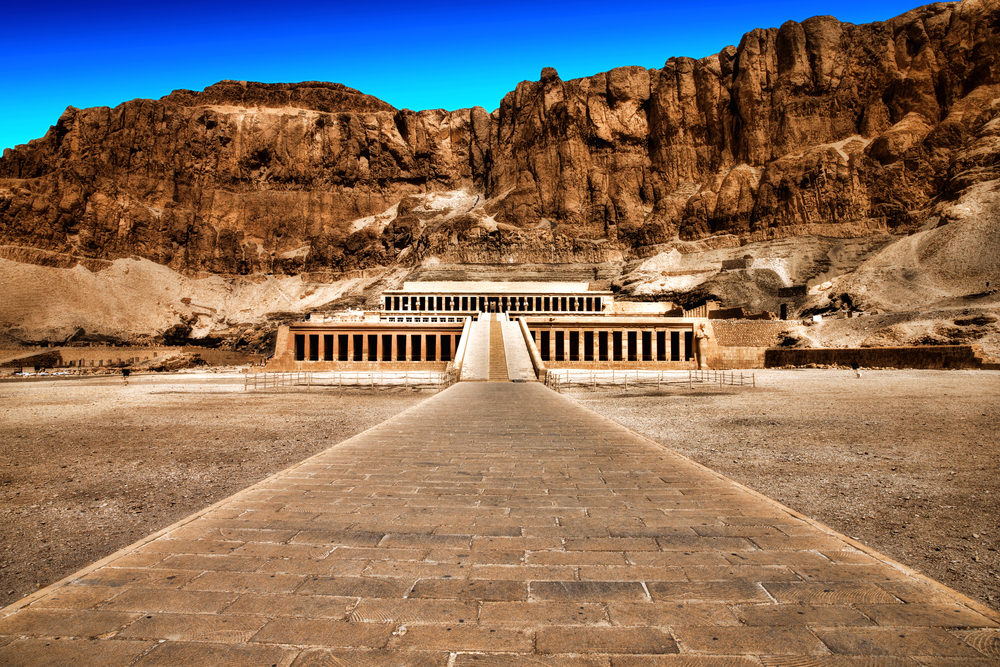- Luxor has often been called the world’s greatest open air museum as indeed it is and much more.
- Within Luxor, there are only three main streets consisting of Al-Mahatta st., al-Karnak st. and the Corniche, next to the Nile. The street in front of the train station is Sharia al-Mahatta and runs away from the Nile where it meets the gardens of Luxor Temple. Sharia al-Karnak or Maabad al-Karnak which means Karnak Temple Street runs along the Nile from Luxor Temple to Karnak Temple. However, Sharia al-Karnak is known as Sharia al-Markaz where it meets Sharia al-Mahatta street, and to the south around the temple it is known as Sharia al-Lokanda.
- In Luxor proper on the East Bank, one of the first stops must be the Temple of Luxor built by Amenophis III. Head south on Sharia al-Karnak to reach the temple, which was connected to the Karnak Temple via a long stone processional street called a dromos.
- About halfway to Karnak, you will discover the Luxor Museum. (The image at left is a Block Statue of Iamu Negh from the Luxor Museum). From the Museum, head back to Sharia al-Karnak and continue north towards Karnak. After crossing a small bridge one will begin to see the excavated dromos off the road and running through a small village. A little further on you will pass the ruins of the Temple of Mut where another dromos leads to the gateway of the tenth pylon. The road finally arrives at the domed tombs of two saints, Sidi Ahmed and Sidi Ali, where a road leads past the Department of Antiquities leads to the main Temple of Karnak entrance.
- After this, you will wish to take a boat trip over to the West bank. The Valley of the Kings is as good as any to try first, with tombs from the 18th and 19th Dynasties. Outside the Valley of the Kings, the road leads past Antef, named for the 11th Dynasty prices who were buried here.
- The road eventually winds itself westward until reaching the Valley of Asasif. These are 25th and 26th Dynasty tombs. At the end of the Valley of Asasif at the foot of a cliff named Deir el-Bahri is a spectacular complex of temples. The Temple of Mentuhetep I, Hatshepsut and Thotmose II here must be seen. Much of the architecture here seems very powerful against the towering cliffs in the background. From here, the road continues past the remains of the temples of Ramses IV and Thutmose III, eventually reaching the Necropolis of Sheikh Abd el-Qurna. This 18th Dynasty necropolis sits amidst houses where there are hundreds of holes. And below here, one comes to the famous Rameseum, built by Ramses II, a huge complex that took twenty years to complete.
- As the road runs along past the remains of Thutmose IV, Merneptah, Ay and Horemheb’s Temples, it finally comes to the huge complex known as Medinet Habu, which is another of Thebe’s major, attractions and a must see sight. The gate has square towers and appears almost oriental. Behind the complex is the workmen’s village called Deir el-Medina. Out in the fields near here is the Colossi of Memnon, one of the major tourist attractions throughout time. Southwest of Deir el-Medina is the Valley of the Queens, where queens of the 18th and 19th Dynasties were buried.
- From here, the road continues past the mud brick remains of the Amenhotep III’s palace called Malkatta. There is a lake to the east and at the other end of that, a small Roman temple called Deir Shelwit and built at the end of the 1st century.
- Hatshepsute / Valley of the Kings / Colossi of Memnon
Visit the Colossi of Memnon, two mammoth pink quartzite statues depicting Amenhotep III sitting on his throne. Continue to the Valley of the Kings for visits to some tombs of the pharaohs (Thutmose III, Ramses III, Ramses VI to name a few). visit the monumental complex of Medinet Habu, comprising the Temple of Ramses III with adjacent palace. with Possibility to visit the Hatshepsute.
East Bank
Visit temple of Karnak dedicated to the god Amun-Ra, creator of the universe. After a rest stop at the Sacred Lake, your tour continues with a visit to the other great Temple of Luxor, once linked to Karnak and originally built as a summer palace for the god Amun. Both these extensive complexes comprise the largest open air Museum in the world.



 Your trustworthy partner
Your trustworthy partner